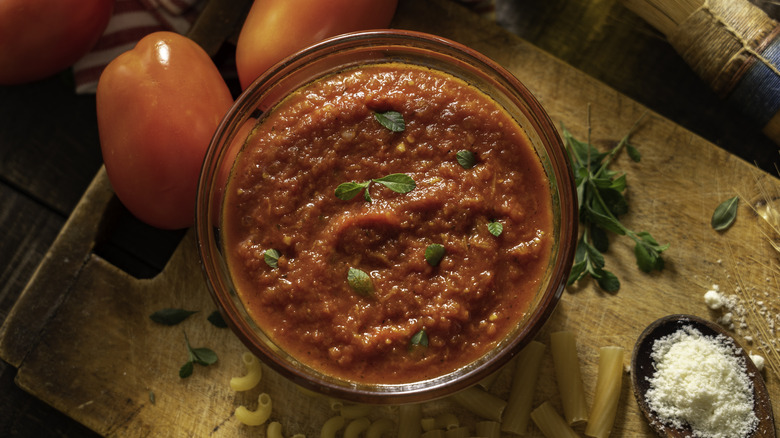Molasses Is The Subtly Sweet Upgrade Your Pasta Sauce Needs
Making pasta sauce from scratch can be tricky to get right, but if it ends up tasting slightly off, usually a dash of sugar can do the trick. This works so well because sweetness counteracts the acidity of tomatoes, which is typically the culprit of subpar pasta sauce. Unfortunately, sugar isn't very forgiving, and it can be hard to tell exactly how much sugar you need because the acidity of the tomatoes depends on what variety you use, how ripe they are, and whether they are currently in season.
For this reason, some recipes instead rely on the natural sweetness of carrots to cut the acidity of the tomatoes. But the more carrots you add, the more the sauce's flavor will change. Even if the tartness is perfectly balanced, the sauce may end up tasting overwhelmingly like carrots. Molasses, on the other hand, offers a more neutral taste and is equally effective.
What happens when you add molasses to pasta sauce?
Like sugar, molasses is also derived from sugar cane but isn't nearly as sweet as its granulated counterpart. This is because after the sugar cane juice is boiled and reduced, the sugar crystals are removed, leaving only the brown syrup behind. This brown syrup — what is bottled and sold as molasses — is still sweet, but it's much more mellow and is offset by a uniquely rich, toasty flavor.
For this reason, molasses is often used in barbecue sauce. It can add sweetness while still letting savory flavors shine; the same effect occurs when you add it to pasta sauce. Ingredients like garlic and onion also blend better with the savory leaning flavors of molasses than they do with pure sugar. Additionally, if you accidentally add too much of it, it may give your sauce a bit of a smoky taste, but it still won't overpower it with sweetness.
How much molasses should you add to pasta sauce?
The amount of molasses you add to pasta sauce will vary based on how acidic the tomatoes are and what type of molasses you use. There are three common varieties of molasses — light (or regular), medium (or dark), and blackstrap. Light molasses is sugar cane syrup that has undergone the least boiling and is the sweetest of the three. As it continues to boil, it turns into dark molasses, then blackstrap molasses, the darkest and least sweet variety.
Light molasses usually works best for baked goods like molasses cream pies, while dark molasses is the most common choice for savory recipes, including pasta sauce. If your tomatoes aren't very acidic but need to be balanced with some sweetness, you may be tempted to opt for blackstrap molasses. However, this is generally not a great idea because blackstrap molasses is also very bitter. For best results, add 1 tablespoon of dark or light molasses at a time, or about 2 tablespoons per can of tomatoes.


